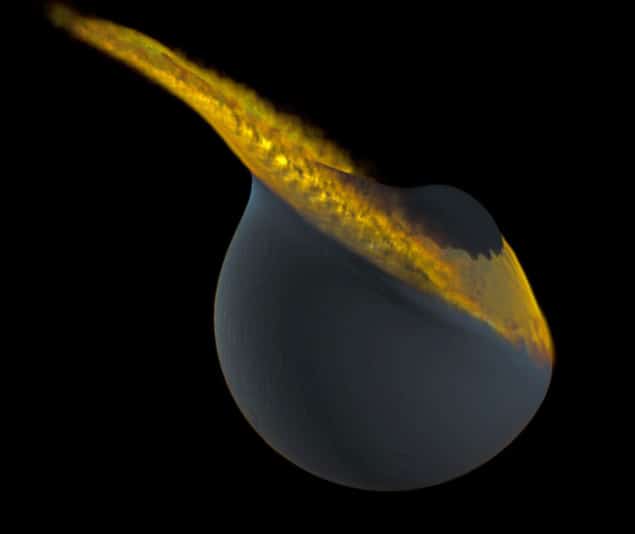
Differences between the near and far sides of the Moon could be the result of a collision between the Moon and a “Trojan” companion that occurred billions of years ago. That is the conclusion of geophysicists in the US and Switzerland who have done computer simulations on how the Moon would be affected by such a massive impact.
Ever since the Luna 3 space mission ventured behind the Moon in 1959, we have known that the nearside and farside of the Moon are different. The nearside (which always faces the Earth) is dominated by relatively smooth basalt plains called “maria”, while the farside is mountainous and deeply pitted with craters. The two sides are also believed to be different beneath the surface, with the nearside crust appearing much thinner than the crust on the farside.
Scientists have several theories for why the two sides are so different. These include tidal heating of the Moon by the Earth’s gravitational field or a piling up of debris from the huge impact crater at the Moon’s south pole.
Now, Martin Jutzi and Erik Asphaug of the University of California, Santa Cruz have done computer simulations that suggest that the lunar farside is the remnant of a collision between the Moon and a smaller companion moon.
Low-speed crash
According to the pair, the companion moon could have been formed at the same time as the Moon – when a Mars-sized planet collided with the Earth shortly after the solar system was formed. This kicked up a vast ring of debris that then orbited our planet, and much of this material is believed to have coalesced rapidly into the Moon. According to Asphaug, it is also possible that one or more smaller moons also formed at stability points within the ring. Such a moon could then have settled into a Trojan orbit, trailing or leading the Moon by 60°. However, this orbit is expected to last only about 100 million years and end with the companion moon crashing into either the Earth or Moon at a relatively low velocity.
It is this latter scenario that Jutzi and Asphaug have modelled using computer simulations. The pair assumed that the companion was about 3% of the mass of the Moon and the two bodies collided at about 2.4 km s–1 or about 8600 km h–1. This velocity is expected in the decay of the Trojan orbit. One important consequence of this slow collision is that the two moons stick together rather than blow apart. “It does not form a crater, but splats material onto one side,” explains Asphaug.
The collision velocity is also much slower than the speed of sound in the rocks that make up the moons, which means than the heat generated by the collision is dissipated efficiently and therefore not much melting of rock occurs.
Instead, the simulations suggest that in the aftermath of the collision a new layer of crushed and fragmented rock was deposited that covered one hemisphere of the Moon. The model suggests that the extent and thickness of this layer is consistent with what we know about the surface of the farside of the Moon. What is more, the simulation also predicts that the collision would push much of the Moon’s magma interior towards the nearside – something that is consistent with lunar temperature measurements.
GRAIL’s gravity map
The researchers now plan to look for clues of a Trojan collision in new data from the Moon. The pair is particularly interested in the gravity map of the Moon’s interior that will be produced by NASA’s GRAIL mission, which is scheduled to launch in September. GRAIL will determine the thickness and structure of the Moon’s crust, which can then be compared with specific predictions of Jutzi and Asphaug’s model.
The researchers are also interested in comparing the ages of rocks from the near and farside. If their theory is correct, then rocks on the farside should be older because they formed on the smaller moon – which would have solidified before the much large Moon.
The research is described in Nature 476 36.



